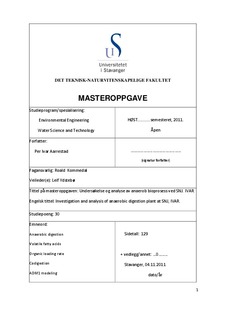| dc.contributor.author | Aarrestad, Per Ivar | |
| dc.date.accessioned | 2012-03-29T09:04:47Z | |
| dc.date.available | 2012-03-29T09:04:47Z | |
| dc.date.issued | 2011 | |
| dc.identifier.uri | http://hdl.handle.net/11250/182478 | |
| dc.description | Master's thesis in Environmental Technology. | no_NO |
| dc.description.abstract | Biodegradation of organic matter by anaerobic digestion is an old sludge treatment technique. The process offers many advantages with effective conversion of a broad range of organic wastes. The major application of anaerobic digestion is the stabilization of concentrated sludges produced from waste water treatment plants (WWTP) and industrial concentrated wastes. A advantages with anaerobic digestion (AD) processes are reduced disposal costs through reduction in waste volumes of waste at the same time converting the organic carbon into biogas, an environmentally sound energy source. The key parameter is determining the biodegradable COD (BIO COD) of influent sludges and characterisation of the organic materials into fractions of polysaccharides, protein and lipids. Investigation and analysis of the dynamic behaviour of digesters with models is useful tool in optimizing, modification and design. The system investigated in this study is the AD reactor at WWTP SNJ in Stavanger, Norway. The AD reactor was monitored in two periods, normal conditions or “steady state” and one injected pulse load for “dynamic state”. The measured and monitored parameters in the two periods were added together and by the model ADM1, systemised and implemented into the software Aquasim for parameter estimations. The extended period of modelling was 150 days. Solids analysis was conducted for process characterization and potential for biogas production. During steady state conditions influent sludge TS was 7 [%] and the VS fraction 74.7 [%], digested sludge TS of 3 [%] of which 48.4 [% was volatile], totally removed COD of 20440 [kgCOD/d] with average biogas production 13076 [Nm3/d]. Organic loading rate (OLR) was fluxing from 1.1- 4.2 [kgVS/m3d]. The stability of reactor pH, volatile fatty acids (VFA`s) and alkalinity (ALK) was analysed. The alkalinity in reactors was measured to be 4500[mg/l] (as CaCO3). Mineralization and measurement of cations NH4+, Ca2+, Mg2+, Na+ and K+ was conducted by Ion Chromatography (IC) for evaluation of ammonium concentrations and alkalinity developments. Ammonium concentration was 690 [mg/l NH4-N] in steady state analysis. [...] | no_NO |
| dc.description.sponsorship | IVAR IKS | no_NO |
| dc.language.iso | eng | no_NO |
| dc.publisher | University of Stavanger, Norway | no_NO |
| dc.relation.ispartofseries | Masteroppgave/UIS-TN-IMN/2011; | |
| dc.subject | anaerobic digestion | no_NO |
| dc.subject | codigestion | no_NO |
| dc.subject | ADM1 modelling | no_NO |
| dc.subject | teknisk miljøvern | no_NO |
| dc.title | Investigation and analysis of anaerobic digestion plant at SNJ, IVAR. | no_NO |
| dc.type | Master thesis | no_NO |
| dc.subject.nsi | VDP::Technology: 500::Environmental engineering: 610 | no_NO |
| dc.source.pagenumber | 129 | no_NO |
